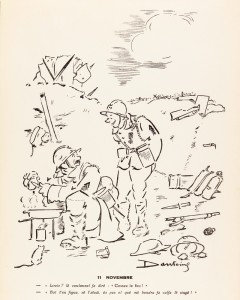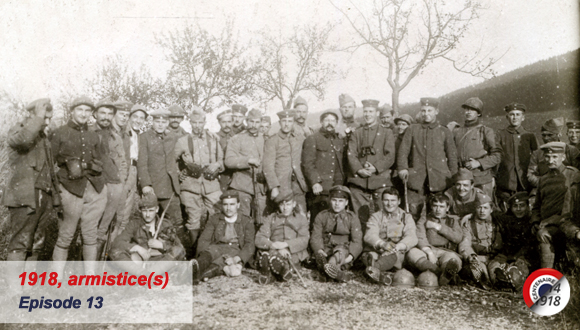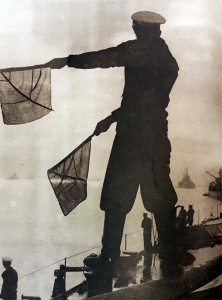 |
 |
Plates 37 and 38 of La Guerre. In 1914, Pierre Dantoine (1884-1955) was mobilised and fought in the 272th IR. Many of his drawings are captioned in Languedoc (he was born in Carcassonne). 43 of his drawings were published in 1932 and 1970 in a booklet entitled The War. On the right, a young French soldier abandons his lookout gun to joke about the ceasefire with a second Frenchman preparing the meal under the watchful eye of a rat. © Paris, musée de l’Armée / Emilie Cambier.
 Photograph taken in the Lingekopf massif located in the Alsatian Vosges. It shows French and German soldiers posing together after the armistice of 11 November 1918 was announced. In this combat zone, the steep terrain made proximity between the belligerents compulsory. © Paris, private collection
Photograph taken in the Lingekopf massif located in the Alsatian Vosges. It shows French and German soldiers posing together after the armistice of 11 November 1918 was announced. In this combat zone, the steep terrain made proximity between the belligerents compulsory. © Paris, private collection
Le Miroir : The conclusion of the armistice reported to the British fleet. On the ships, signal flags or pavilions, were used to visually announce the armistice. © Paris, musée de l’Armée
A regiment parading through Montrouge on the evening of the Armistice by Lucien Simon. © Paris, musée de l’Armée, dist. RMN-GP / Emilie Cambier
Announcement to soldiers
The hostilities are stopped
By telegraph, Marshal Foch announced the end of the war to the commanders-in-chief of each of the Allied armies, on November 11 at 5:15 a.m.: “The hostilities have been stopped all along the front, as at 11 November, 11 a.m. (French time). The Allied troops will not, until further notice, exceed the line reached on this date and at this time.”
On November 11, Menditte commander wrote in his notebook: “At around 6:30 a.m., rumours of the armistice began to go around. At 8:30 a.m., the notice was official. Meanwhile, shooting continued on the front of the regiment and German shells fell on Dom-le-Mesnil. I will pass on the good news to the regiment and wait! 11 a.m.: one of my clairons has sounded Cease-Fire, Rise, then To the Flag. The others are repeating. The Marseillaise is rising in the distance. Cries of joy and the more distant cries of the Krauts coming out of their holes and wanting to fraternise. What joy, what emotion! ”
At 9 p.m., General Pétain signed the last press release written by Pierrefeu’s second lieutenant: “In the 52nd month of war unprecedented in history, the French army, with the help of its Allies, has consummated the enemy’s defeat. Our troops, animated by the purest spirit of sacrifice, offering for four years of uninterrupted fighting an example of sublime endurance and daily heroism, fulfilled the task entrusted to them by the Fatherland. Sometimes with indiscriminate support for the enemy’s assaults, sometimes attacking themselves and forcing the Victory, they, after a decisive attack of four months, shaken, battered and booted out of France, the powerful German army and forced it to ask for peace. All the conditions required for the suspension of hostilities having been accepted by the enemy, the armistice came into effect this morning at 11 a.m.”. The Musée de l’Armée keeps the manuscript of this press release.
Finally, on 12 November, in his military agenda, Foch announced the victory: “Officiers, Second-Officers, Allied Soldiers of the Armed Forces. After resolutely stopping the enemy in its tracks, you have for months, with unrelenting faith and energy, attacked without respite. You have won the greatest battle in history and saved the most sacred cause: freedom in the world. Be proud. With immortal glory, you have adorned your flags, and posterity shall keep its gratitude to you.”
Military parades
For the government, it is important to show that the Army is still mobilised. For many Allied combatants then, began parades in Paris, Alsace-Lorraine, Germany, etc. The parades are both a form of recognition, but also a source of fatigue and sometimes a shock to see the reactions of civilians after so many sacrifices.




Ajouter un commentaire